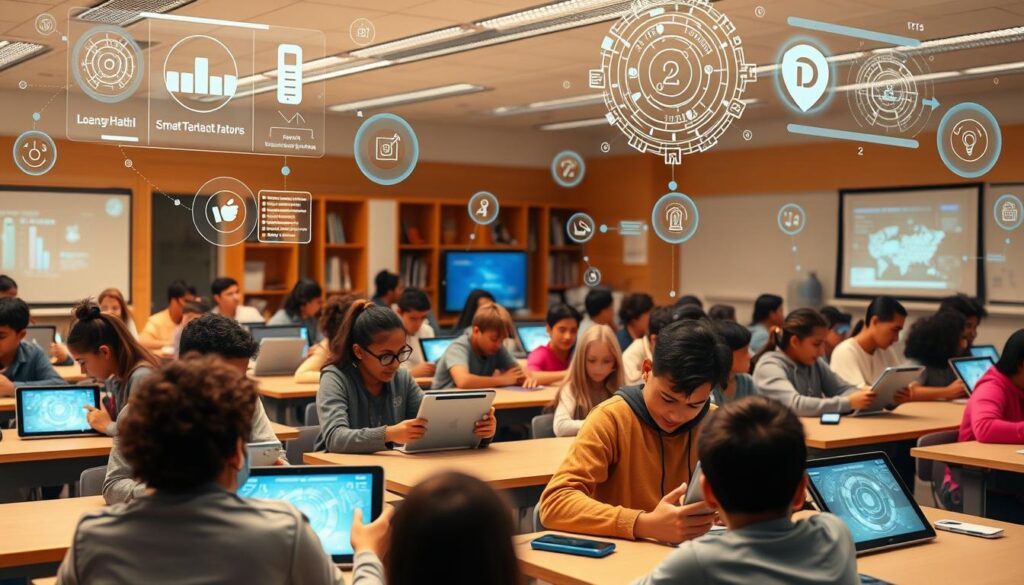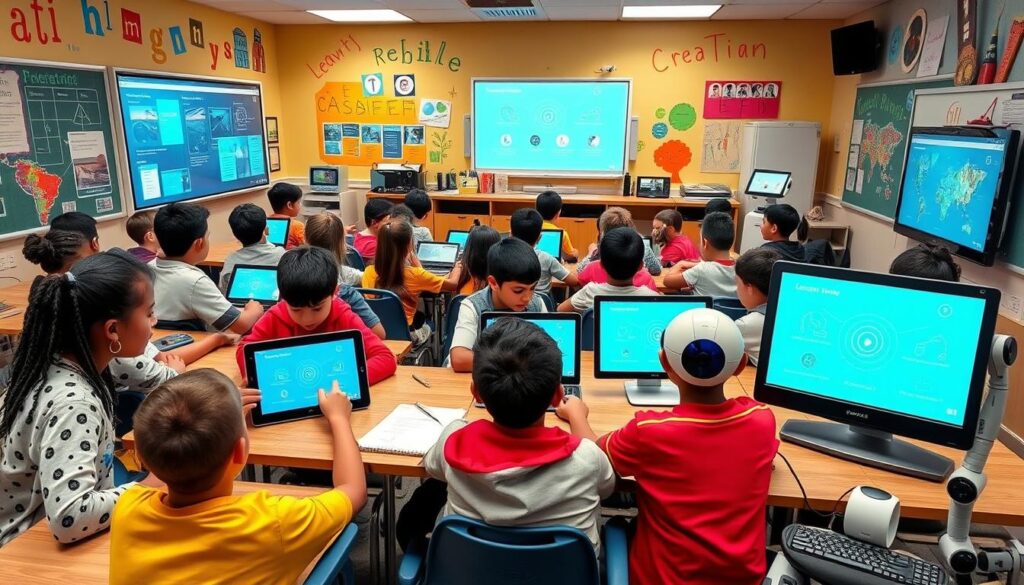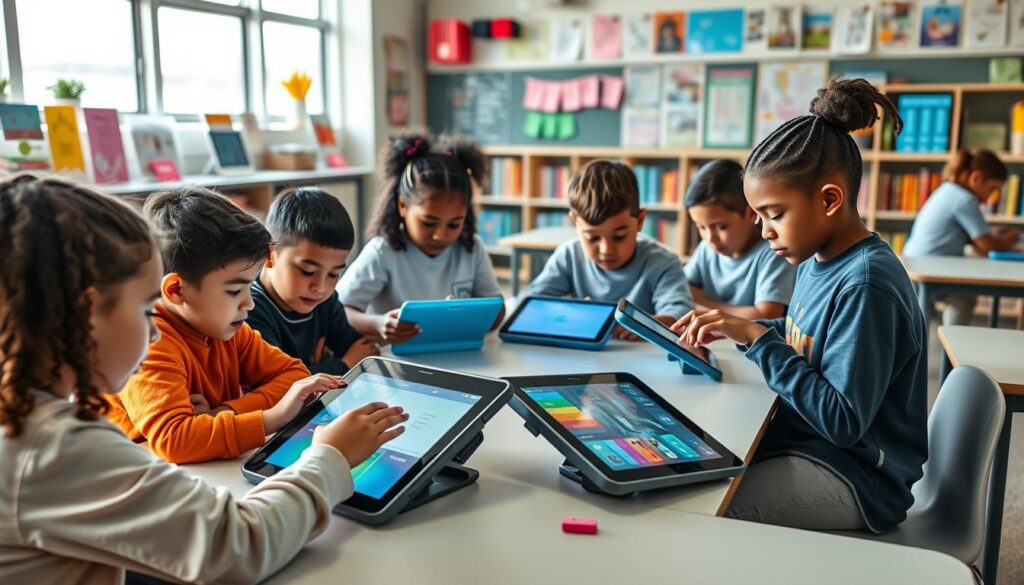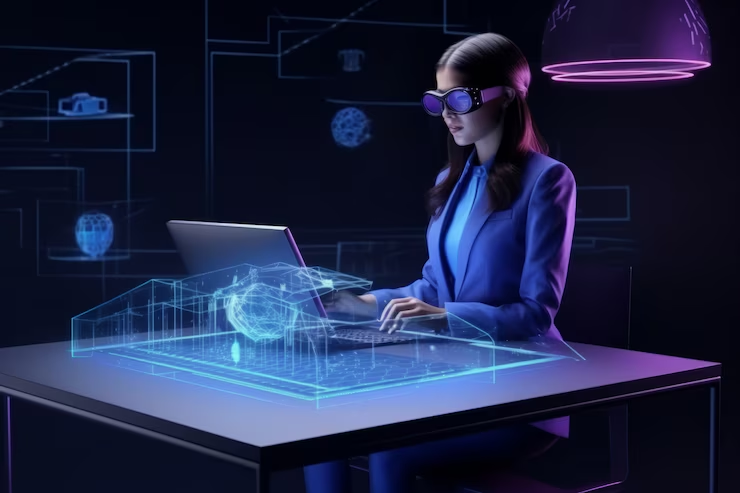Artificial intelligence (AI) has moved from science fiction to real life, changing Educational Technology many areas, including education. It’s changing how students learn and get ready for the future. A McKinsey Global Institute report says AI could add $13 trillion to the global economy by 2030.
AI’s true power is in changing what we thought was possible. It makes everyday tasks better and opens up new creative possibilities. In education, AI can make learning more personal, efficient, and interactive.
Key Takeaways
- AI is revolutionizing the education sector, transforming the way students learn and prepare for the future.
- AI-powered technologies are enabling more personalized, efficient, and interactive learning experiences.
- Educators are increasingly adopting AI tools in their classrooms, with younger teachers leading the charge.
- The integration of AI in education has the potential to create $13 trillion in global economic activity by 2030.
- Educators recognize the need for comprehensive education on the ethical use of AI in the classroom.
AI as a Catalyst for Enhancing Teaching Effectiveness
Artificial Intelligence (AI) is changing how we teach in the digital world. It uses advanced tech like machine learning and natural language processing. This is making learning better for everyone.
Personalized Learning Experiences
AI creates learning plans that fit each student’s needs and pace. It looks at lots of data to understand how each student learns best. This way, learning becomes more fun and effective.
AI also helps with virtual tutoring. It gives students feedback and guidance, making learning even more personal.
Streamlining Administrative Tasks
AI is making school work easier for teachers. It helps with grading and keeping track of who’s there. This lets teachers focus more on teaching and helping students who need it.
Real-Time Insights and Data Analytics
AI gives teachers insights into how students are doing. It helps spot where students might need extra help. This way, teachers can tailor their teaching to meet each student’s needs.
Fostering Professional Development
AI helps teachers grow professionally too. It offers new tools and ways to learn. This keeps teachers up-to-date with the latest in education technology.
AI is making a big difference in teaching. It makes learning more personal, eases teacher work, and helps teachers improve. This means better learning for students and prepares them for the future.
The Rise of Personalized Learning with AI

In today’s tech world, AI is changing education. It makes learning personal. AI looks at each student’s data to give them content and paths that fit their needs and learning style.
AI also helps with real-time feedback and support. It finds where students need help and gives them the right help. This makes learning more effective and fun, moving away from the old one-size-fits-all teaching.
AI also helps teachers by giving them data to see how students are doing. This lets teachers focus on helping and guiding, not just teaching. It’s a new way for teachers and AI to work together.
Systems like Khan Academy and Duolingo show how AI can make learning better. They use AI to make learning paths that fit each student. This makes learning more fun and effective.
As AI gets better, so will personalized learning. New tech can make learning even more tailored to each student. It will focus on what each student is good at and needs to work on.
But, using AI in schools also raises questions. We need to make sure data is safe, everyone has access to tech, and teachers know how to use it. These are important steps to make AI in schools fair and right.
“AI has the power to transform education by creating personalized learning experiences that cater to the unique needs of every student, revolutionizing the way we teach and learn.”
The future of education looks bright with AI. It promises better learning, more fun, and fairness for all. By using AI wisely, we can make education better for everyone.
Evaluating the Pros and Cons of AI in Education
Artificial intelligence (AI) is changing education fast. It can make learning more personal, efficient, and accessible worldwide. But, there are worries about bias, unfairness, privacy, and losing the human touch.
Positive Aspects
AI can make learning fit each student’s needs. It uses data to adjust content and pace, helping students understand better. It also helps teachers by doing tasks like grading, so they can focus on teaching and helping students.
AI also makes learning available to everyone, no matter where they are. This opens doors to quality education for students all over the world.
Negative Aspects
But, AI in education comes with its own set of problems. There’s a risk of AI systems being unfair if they’re trained on biased data. This could make learning worse for some students.
There are also worries about privacy. How AI uses student data needs to be watched closely. Some people think AI might make learning less personal and less fun.
There are also fears that AI could replace teachers, which could be bad for students. Finding a way to use AI wisely is important for education’s future.
It’s vital to find a way to use AI that works for everyone. We need to make sure it helps, not hurts, our education system.
| Pros of AI in Education | Cons of AI in Education |
|---|---|
| Personalized learning experiences | Potential for bias and inequity |
| Streamlining administrative tasks | Privacy concerns |
| Enhancing global accessibility | Diminishing human connection |
| Improving efficiency and time-saving | Ethical considerations around job displacement |
“The integration of AI in education is a complex issue that requires a balanced and responsible approach, addressing both the benefits and the challenges to ensure a positive and inclusive learning future.”
AI Shaping the Future of K-12 Educational Technology

Artificial intelligence (AI) is changing education in big ways. It’s making learning more personal, using data to improve teaching, and reaching students all over the world. AI helps tailor lessons to each student’s needs, making learning more fun and effective.
Teachers get valuable insights from AI, helping them teach better. AI also makes online learning possible, opening doors for students in remote areas. This makes learning more inclusive for everyone.
AI tools like virtual tutors and games are key in teaching important skills. They help students think critically and solve problems. As AI gets better, it will make learning even more personal and accessible to all.
| AI Adoption in K-12 Education | Percentage |
|---|---|
| Successful AI deployment in educational institutions | 30% (2024) |
| School administrators supporting AI integration | 41% |
| Teachers supporting AI integration | 21% |
| Teacher tasks that can be automated using existing AI tools | 20-40% |
| Average number of tech applications used by K-12 school districts in the U.S. | 2,500 |
But, there are still challenges like bias and ensuring data privacy. As more schools use AI, it’s important to do it wisely. This way, we can make learning better for everyone, preparing students for the future.
“The efficacy of new AI applications in education is a slow process, with an example of an ongoing Randomized Control Trial (RCT) of Khanmigo in Canada likely taking a few years for results.”
– Stéphan Vincent-Lancrin, OECD
The Disruptive Potential of AI in Educational Technology

The education sector is on the verge of a big change with the rise of artificial intelligence (AI). AI is changing how we teach and learn. It promises to make education more personal, fitting each student’s unique needs and learning style.
AI is also changing how we teach, making it more focused on students. It helps teachers give feedback and insights in real time. This makes learning more student-centered and based on data. AI also makes learning available to more people, breaking down barriers and making education more inclusive.
New learning models, like virtual classrooms and adaptive learning platforms, are changing the classroom. Teachers are now more like mentors, helping students on their learning journey. They focus on creativity, emotional support, and guiding students.
But these changes also bring up big questions about fairness, privacy, and using data wisely. It’s important to handle these issues well to make sure AI helps everyone learn better.
“AI has the potential to radically change the landscape of education, forcing the educational system to abandon traditional teaching practices.”
The rise of AI in education is set to bring big changes. By using these new technologies and thinking about ethics, we can make learning better for everyone. This will help students reach their highest potential.
Also Read : Top Skill Development Courses On Online Learning Platforms
Conclusion
Artificial intelligence can change education in big ways. It offers tools to make teaching better, learning more personal, and the learning space more open. AI can help teachers by doing routine tasks, giving insights, and making learning fit each student’s needs.
AI’s growth means it could change how we learn and teach. It prepares students for the jobs of today and tomorrow. But, using AI in schools must be done right, with care for fairness, privacy, and keeping human touch.
Working together, teachers, leaders, and tech experts can make AI work for education. This way, AI can help make learning better and more personal. By using AI wisely, education can meet the challenges of today and tomorrow, helping everyone learn and grow.
FAQs
Q: How does instructional technology influence student learning in edtech?
A: Instructional technology significantly enhances student learning by providing innovative educational tools that create engaging learning opportunities. It allows for personalized learning experiences and supports various learning styles, making education more effective.
Q: What are some examples of edtech tools that facilitate the use of technology in education?
A: Examples of edtech tools include learning management systems (LMS) like Moodle and Canvas, educational apps for mobile devices, virtual reality applications for immersive learning, and online course platforms that promote distance learning and blended learning environments.
Q: How can teachers effectively integrate technology into the classroom?
A: Teachers can integrate technology into the classroom by utilizing instructional technology that complements their curriculum, such as interactive whiteboards, assistive technology for diverse learners, and educational software that aligns with learning objectives. This approach enhances teacher instruction and engages students in the learning process.
Q: What role do learning management systems play in the education program?
A: Learning management systems play a crucial role in the education program by providing a centralized platform for course management, facilitating communication between students and teachers, and enabling the organization of learning materials and assessments, which enhances the overall learning experience.
Q: How has the use of educational technology evolved with the rise of online education?
A: The use of educational technology has evolved significantly with the rise of online education, allowing for fully online programs and asynchronous learning options. This evolution has made education more accessible and flexible, catering to the needs of diverse learners.
Q: What is the impact of virtual reality and augmented reality on student learning?
A: Virtual reality and augmented reality have a profound impact on student learning by providing immersive experiences that enhance engagement and understanding. These technologies allow students to explore complex concepts in a hands-on manner, making learning more interactive and memorable.
Q: How do flipped classrooms utilize technology to improve the learning process?
A: Flipped classrooms utilize technology to move traditional teaching methods outside of the classroom, allowing students to engage with instructional materials at their own pace. This approach encourages active learning during class time, where students can apply concepts through collaborative activities and discussions.
Q: What are some challenges educators face when incorporating technology tools into instruction?
A: Educators may face challenges such as a lack of training in using technology tools effectively, resistance from students or parents, and technical issues that can disrupt the learning process. Additionally, ensuring equitable access to technology for all students can be a significant hurdle in implementing innovative educational practices.
Q: How can assistive technology support diverse learners in the classroom?
A: Assistive technology supports diverse learners by providing tailored resources and tools that address individual needs, such as text-to-speech software for students with reading difficulties or communication devices for those with speech impairments. This technology enhances learning opportunities and promotes inclusivity in the classroom.
Q: What is the significance of a master’s in educational technology for today’s teachers?
A: A master’s in educational technology equips today’s teachers with the skills and knowledge necessary to effectively integrate technology into their instruction. This advanced degree prepares educators to design innovative learning environments, assess the impact of technology on student learning, and lead the way in implementing best practices in the use of educational technology.
